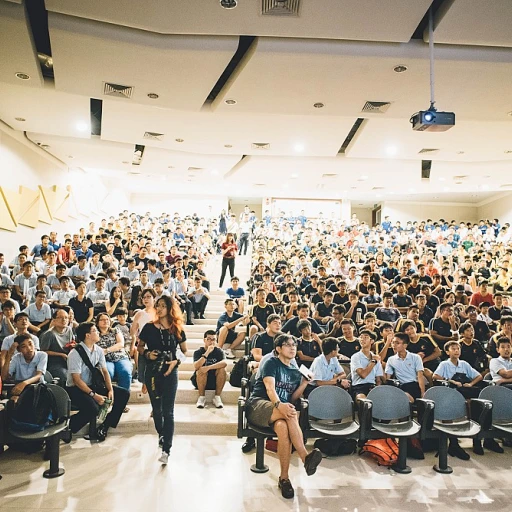
Understanding the Importance of Leadership Goals
The Significance of Leadership Goal Setting
Leadership goal setting is much more than just a task on a checklist—it's a critical process that shapes the future of an organization. By defining clear leadership goals, organizations can create a work environment that not only promotes effective leadership but also enhances team dynamics and overall company performance.
Effective leadership goals are designed to challenge leaders to improve their leadership skills and emotional intelligence. In doing so, these goals foster better communication and stronger relationships with team members. It's not just about individual growth; it's about creating a ripple effect of development throughout the entire organization.
Leaders must consider incorporating SMART goals—specific, measurable, achievable, relevant, and time-bound—when setting their goals. This structured approach to goal setting ensures that leaders remain focused and can track their progress over time. SMART goals help leaders to align their personal growth with the broader objectives of their team and organization.
Additionally, integrating feedback and constructive criticism into the goal-setting process is essential. By doing so, leaders can identify key areas for improvement and continuously refine their strategies. To support their development journey, leaders should explore career paths in leadership development programs as they provide valuable insights and resources for enhancing leadership capability.
In essence, setting effective leadership goals is about more than leadership itself; it's about ensuring a harmonious work environment and preparing future leaders for success.
Identifying Key Leadership Competencies
Essential Leadership Skills for Success
Recognizing the key leadership competencies is crucial in any succession planning strategy. These skills serve as the foundation for effective leadership and help in the smooth transition of team roles. It's not just about inheriting a title; successful leaders possess a range of competencies essential for inspiring and guiding their team members towards shared goals.- Emotional Intelligence: Effective leaders should understand and manage their own emotions while also being attuned to the feelings of others. This competency helps in fostering better communication and relationships within the organizational environment.
- Communication Skills: Clear and concise communication ensures that goals, expectations, and feedback are effectively transmitted. Leaders with strong communication abilities are better equipped to resolve conflicts and build trust among team members.
- Time Management: With a multitude of responsibilities, leaders need to efficiently manage their time. Proficiency in prioritizing tasks under tight deadlines is crucial to achieving both short-term and long-term objectives.
- Goal Setting: Setting clear and specific goals, often embodied in the SMART goals framework (Specific, Measurable, Achievable, Relevant, Time-bound), is necessary to track progress and measure success.
- Adaptability: The business landscape is continuously evolving. Leaders need to be flexible in adjusting their approaches and strategies, ensuring they can lead effectively in changing environments.
- Constructive Criticism: Providing and receiving feedback facilitates development. Leaders who can offer constructive criticism not only help improve individual performance but also foster a supportive work environment.
Aligning Leadership Goals with Organizational Vision
Align Leadership Goals with the Organization's Vision
Leadership goals are most effective in the context of the broader organizational vision. They should not exist in a vacuum but rather align with the company's mission and long-term objectives. This alignment ensures that as leaders develop, they contribute meaningfully to the company's strategic goals and encourage team members to do the same.
To align leadership goals effectively, consider the following steps:
- Clearly Define Organizational Objectives: Start by understanding your company's vision and strategic priorities. This will help you identify specific leadership goals that support these objectives. Whether you're focusing on team collaboration, improving communication, or fostering emotional intelligence, tying these elements to the company's mission will enhance their relevance and impact.
- Adopt the SMART Goals Framework: Using Specific, Measurable, Achievable, Relevant, and Time-bound (SMART) goals can offer leaders a structured approach to goal setting. For instance, a leadership goal might be to "improve time management skills by reducing project delivery time by 15% within three months." This aligns with the company's efficiency objectives while being specific and measurable.
- Encourage Feedback and Flexibility: Create avenues for open communication and constructive criticism. Regular feedback from team members and peers can reveal whether leadership goals are on track or require adjustments. Flexibility in adapting goals to current work environments while keeping organizational vision in sight is crucial.
- Incorporate Development Programs: Invest in leadership development programs that emphasize skills critical to achieving organizational goals. Providing leaders with resources and training tailored to the company's objectives will empower them to deliver better performance. For more tips on such alignment, explore this guide on building strong business leadership.
By ensuring leaders’ objectives are tightly knitted into the company’s overarching goals, organizations can foster a growth-oriented work environment that not only benefits individual leaders but also drives the collective progress of the business.
Incorporating Flexibility in Leadership Goals
Infusing Flexibility into Leadership Goals
In the dynamic business landscape, incorporating flexibility into leadership goal setting is crucial to ensuring successful leadership development. While setting specific, measurable, achievable, relevant, and time-bound (SMART) goals is essential, being adaptable to evolving circumstances must be integrated into the process.- Adapting to Change: Businesses operate in ever-changing environments. Leaders must be open to adjust their goals in response to unforeseen challenges or opportunities. This does not mean discarding their objectives but refining or expanding them to meet the new context.
- Responsive to Feedback: Continuous feedback from team members, peers, and mentors provides invaluable insights for leaders. Constructive criticism helps refine leadership competencies, improve relationships within a team, and better manage team dynamics. Building a feedback loop encourages leaders to develop emotional intelligence and adapt goals accordingly.
- Balancing Short and Long-Term Objectives: While setting leadership goals, it is crucial to strike a balance between achieving long-term visions and addressing immediate needs. Incorporating flexibility enables leaders to pivot their strategies without losing sight of overarching objectives. For example, if a leadership development goal is to improve communication skills over three months, the leader might find that devoting more time to listening actively improves team morale significantly.
- Encouraging Creative Solutions: Flexible leadership goals foster an environment where creative problem-solving is encouraged. By allowing room for innovative approaches, leaders empower employees to contribute toward achieving developmental goals effectively. This flexibility, combined with clear communication, strengthens the work environment.
Measuring Success in Leadership Development
Defining Metrics for Leadership Success
Establishing structured approaches to evaluate leadership goals is crucial for effective succession planning. To ensure that leadership development aligns with your organizational vision, it's essential to focus on key indicators that will help measure success in this area.- SMART Goals: Leveraging the SMART (Specific, Measurable, Achievable, Relevant, Time-bound) framework can significantly improve your leadership goal-setting process. By setting SMART goals, leaders can focus on outcomes and establish clear metrics for success, including emotional intelligence, communication, and time management.
- Continuous Feedback: Regular feedback from team members and peers can provide valuable insights into a leader's progress. Constructive criticism helps leaders identify areas for improvement and adjust their strategies to better align with the organization's vision. This ongoing dialogue promotes a work environment focused on growth and continuous improvement.
- Development Benchmarks: Tracking development goals over time can help assess a leader's growth. Using specific benchmarks, such as achieving designated leadership skills within three months, helps establish accountability. These benchmarks should be specific to the development of competencies necessary for the organization.
- 360-Degree Reviews: Implementing comprehensive reviews allows for an in-depth evaluation of a leader’s performance, covering various aspects such as relationship-building with team members, emotional intelligence, and effective goal setting. This all-encompassing view provides a holistic measure of leadership success.
Overcoming Common Challenges in Setting Leadership Goals
Addressing Obstacles in Leadership Goal Setting
Setting leadership goals plays a crucial role in ensuring a smooth succession planning process. However, it is not without its challenges. Let's explore some common obstacles leaders and teams face when setting these goals and ways to overcome them.- Lack of Specificity: Leadership goals must be specific to provide clarity and direction. Without clear objectives, leaders may find it difficult to focus their efforts on developing the necessary skills. Using SMART goals as a foundation can help lend specificity and trackability to the process.
- Insufficient Feedback: Constructive criticism and feedback are essential in refining leadership skills and development goals. Regular communication among team members and leaders enhances understanding and helps identify areas for improvement.
- Inflexible Goals: As discussed earlier, incorporating flexibility into leadership goals is vital. The business environment is constantly changing, and goals must adapt to existing situations. Allow room for adjustments and recalibrate goals as needed to ensure they remain aligned with organizational vision and priorities.
- Time Management: Leaders and teams often juggle numerous responsibilities, making it challenging to allocate sufficient time to leadership development. Enforcing a time-bound approach by setting clear timelines optimizes time management and helps keep leadership goals on track.
- Limited Emotional Intelligence: Developing emotional intelligence in leaders can greatly enhance relationship-building and communication skills within a team. Dedicating resources to improve emotional intelligence can go a long way in achieving leadership objectives and creating a supportive work environment.
- Ineffective Goal Alignment: Ensuring leadership goals align with the organization's long-term vision is essential. Clear alignment facilitates a cohesive approach to leadership development, paving the way for potential leaders who embody the company's values and goals.












